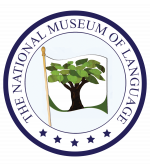
The unfortunate global pandemic has sidelined many a museum. However, One museum that has arguably even flourished because of it is the National Museum of Language (NML).
In 2008, the museum opened to the public in College Park, Maryland, amidst much fanfare as it was a unique experiment regarding languages.
Everyone is familiar with museums where you see (and sometimes touch) physical objects like airplanes or bleached bones. But language, one might think, is mainly sounds and words and books. Since libraries exist for that type of thing, what would a language museum do? NML from day one adopted three themes that have governed its presentations, exhibits and programs ever since: (1) Universal Aspects of Language; (2) Language in Society, and (3) Languages of the World. Said simpler, “if it is language related, NML is interested.” When it opened, there really was no other museum of its kind anywhere—and certainly not in the U.S.
NML actually originated from a 1971 public language exhibit sponsored, interestingly, by the National Security Agency (NSA). Dr. Amelia C. Murdoch, who had helped organize the event for NSA, wanted to create a public language museum in her retirement. When NML was officially created in 1997, she finally realized her dream although a brick-and-mortar museum for visitors would have to wait until 2008.
From 2008-2013, the museum offered exhibits that truly demonstrated both potential and variety. Its longest running exhibit, “Writing Language: Passing It On,” compared alphabetic writing systems (e.g., Greek) and pictographic writing systems (e.g., Japanese). Another exhibit, “Emerging American Language in 1812,” commemorated the 200th Anniversary of the War of 1812 by looking at the English language of the time. This exhibit included a colorful exhibit on Noah Webster, the father of American English. Its third exhibit, “Glimpses of French in the Americas,” introduced the exceptionally diverse universe of French dialects and creoles in the Western Hemisphere.
NML had some interesting display items, like a language tree, which allowed visitors to trace their language roots. The world’s only International Flag of Language (created by the Museum to represent languages past, present, and future) hung there. There were also plenty of activities. You could take an 1812 spelling test or review rare foreign language sacred texts. Children, frequent visitors to the museum, could practice writing characters in Chinese, guess the origins of Native American words, translate their names into other languages, or play an online language game.
The strategic decision was made in 2013 to close down the brick-and-mortar facility and go virtual, making it among the first ever totally virtual museums. Its first exhibit under the new format provided an interactive way for visitors to learn about how young linguistic field researchers travelled around the U.S. in the mid-1960s collecting words and audio recordings for the Dictionary of American Regional English (DARE). For this endeavor, NML partnered with the DARE project coordinators from the University of Wisconsin. A simulation game places you in the role of a field worker and lets you try to overcome the kinds of challenges they faced in collecting data on American English variation.
Since NML was now virtual, much attention was given to creating a quality website. Over time, the site developed three regular features: (1) interviews with leading linguists all over the world; (2) “language of the month” and (3) “teachers’ corner,” i.e., tips for language instructors. One truly unique feature is Philogelos. Typically translated as “the joker” or “the one who loves laughter”, Philogelos is an ancient Greek collection of approximately 265 jokes. Dating to the 4th or 5th century CE, it is arguably the world’s oldest surviving collection of jokes.
The museum responded to the challenge of COVID-19 by expanding partnerships and activities. The best manifestation of this has been the Multilingual Digital Storytelling exhibit, launched in cooperation with the Gaithersburg, MD, Book Festival. This exhibit showcases children’s stories in a growing list of languages (14 so far). NML has continued to hold the Amelia Murdoch Annual Speaker Series but has now made it entirely virtual, attracting speakers and numbers that would not have been possible before. Another new virtual initiative, spurred by COVID-19, includes periodical language trivia nights. These now focus on specific languages, e.g., Chinese. NML is also finetuning its first self-guided virtual tour.
As part of its Moveable Museum strategy, NML lends out display items (e.g., its International Flag of Language) to other museums. Although temporarily suspended for COVID reasons, NML has even expanded its language camps by developing an add-on world language component to local recreation programs. Finally, NML is aggressively pursuing language liaisons to establish links with educators. Established language professionals, representing nine states so far, have volunteered their precious time to this important endeavor.
The ultimate goal remains to return to a brick-and-mortar facility. As it pursues that dream—and “inspires an appreciation for the magic and beauty of language”—NML welcomes the ideas and participation of everybody to whom language is important, including you. To learn more, visit www.languagemuseum.org.
Gregory J. Nedved has been involved with the National Museum of Language since it first opened to the public in 2008 and has been its president since 2019. For many years, he was a Chinese-Mandarin linguist for both the U.S. military and government. Currently, he is a Department of Defense historian focusing on Asian and language history.





